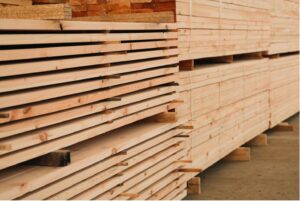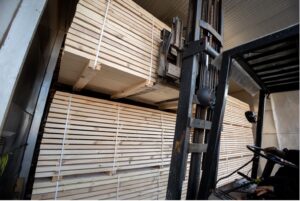
Wood is today one of the main raw materials used in various industries. We are talking about an environmentally friendly, renewable and versatile material, whose properties often clash with production requirements due to its perishability over time and low dimensional stability. Hence the need to subject wood to different processes, with the aim of improving its performance. High-temperature heat treatment, using drying systems, offers a sustainable and easy-to-apply solution for processing this material and obtaining a high-quality finished product.
In this article, we will analyse all wood drying technologies, identifying the most suitable solutions according to the characteristics of each wood species.
The characteristics of wood species to be taken into account before drying them
The wood drying process must necessarily take into account the peculiarities of each species, especially its physical-mechanical properties:
- Strength: this is a measure of the ability of wood to resist various forms of stress, such as compression, tension, bending and torsion. Strength depends on several factors, including the wood species, its density, humidity, temperature and the presence of defects such as knots, cracks or woodworm.
- Hardness: expresses the material’s ability to resist permanent deformation due to, for example, penetration by an external object. Wood hardness can vary significantly from one wood species to another and can be affected by factors such as density, the presence of lignin, cell structure and the presence of any defects such as knots or cracks. Importantly, the hardness of wood varies with temperature. The drying process must take this factor into account since hardness decreases as the treatment temperature increases.
- Stiffness: measures the ability of wood to resist elastic deformation when subjected to external loads or stresses. This parameter depends mainly on its cell structure, density, chemical composition and the presence of any defects.
- Density: indicates the amount of mass present per unit volume of wood. Denser woods have more woody material per unit volume, while less dense woods have less material.
The combination of all these parameters is decisive for the results of the wood drying process. Knowing the physical-mechanical properties of each wood species is important to be able to optimally set all the drying parameters of the material, including temperature, humidity and ventilation. Drying too quickly can cause irreversible damage to the wood, while too slow a process can encourage the proliferation of mould and fungi. Maintaining an ideal balance between all these factors is essential to ensure satisfactory results and to preserve the structural and aesthetic characteristics of wood. Each wood species, depending on its properties, will require different heat treatment.
Conventional drying systems
Conventional drying systems operate on the principle of air exchange through feeding supplied by any thermal fluid or energy source. Our conventional drying systems are divided into:
- Conventional ICD dryer: this system is fed by a thermal fluid, which is heated by means of specific heat exchangers with bimetallic finned tubes. Motorised dampers ensure regular air exchange. The fluids used are hot water, superheated water, diathermic oil and steam.
- Conventional TAG dryer: fuelled by natural gas, LPG, diesel or renewable energies, this system is equipped with a burner that provides direct heating, without the need to install an external boiler. The solution is particularly advantageous because for a low initial investment, you get a highly efficient, low-consumption system.
- Conventional IDV dryer: this system is characterised by the presence of viscous dissipation cells. Heat is generated through a viscous dissipation process that transforms the air generated by the fans into thermal energy. Our IDV model offers significant savings in terms of operating costs.

Condensation drying systems
Condensation drying systems use an approach based on air recirculation and dehumidification to dry wood. This process takes place by means of a refrigeration circuit integrated in the machine that uses a heat pump to reduce heat consumption. The power supply is mainly electrical, but additional batteries can be integrated to ensure the continuity of heating with thermal fluid.
Our condensation drying solutions are mainly two:
- MAC condensation dryer: thanks to the heat pump provided, this system offers significant energy savings by optimising the machine’s refrigeration system. The cold generated is used to condense and expel the moisture evaporated from the wood, while the heat is used to heat the wood and accelerate the evaporation of the water it contains. Drying takes place mainly by air recirculation and only at certain times by expulsion.
- MAC-Hybrid condensation dryer: this system combines the advantages of conventional and condensation drying, using both electrical and thermal energy more efficiently. With this solution it is possible to reduce the investment burden related to boilers and their maintenance, with the guarantee of benefiting from all the advantages offered by an efficient and scalable system according to specific drying requirements.
High-temperature systems
Depending on the requirements of the product, the heat treatment of wood can take place at very high temperatures, from 90°C to 250°C. Thanks to our high-temperature systems, it is possible to dry wood with the combined action of heat and steaming. This treatment makes it possible to adjust the desired colouring of the material, as well as giving it greater stability and weather resistance. Our solutions include:
VAP high temperature wood steaming chamber: The VAP steaming chamber is fed by various heat sources, including steam, superheated water, diathermic oil and direct gas or diesel heating systems. This kiln is designed with a high level of thermal insulation to ensure efficient cycle control. It is monitored by two temperature probes, allowing precise process control.The steaming process of the wood, facilitated by the VAP kiln, is fundamental to the drying process. This technique can be applied to all wood species and, depending on the duration of the treatment, may even out the colour of the wood or impart particular shades. During this operation, the wood is exposed to high temperatures and high humidity, recreating a saturated steam environment.
There are two main types of steaming chambers for wood: direct and indirect. In direct steaming chambers, saturated steam is injected directly into the kiln through a perforated pipe. In indirect steaming chambers, steam is generated in a tank containing coils through which superheated water, steam or diathermic oil flows. Steam can be generated using gas or oil burners equipped with heat exchangers.
